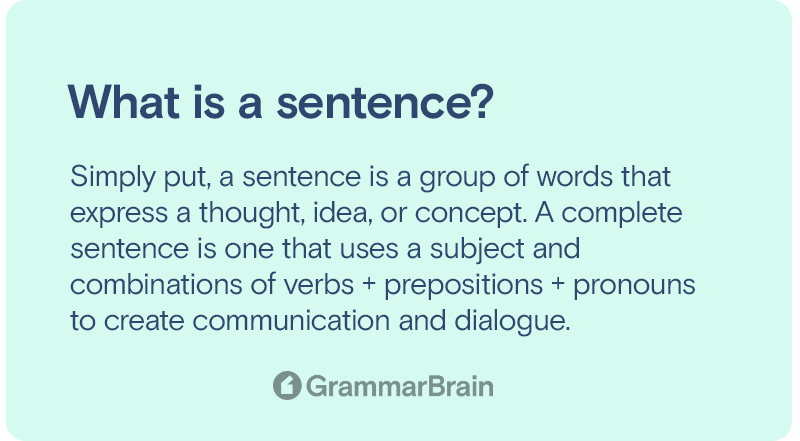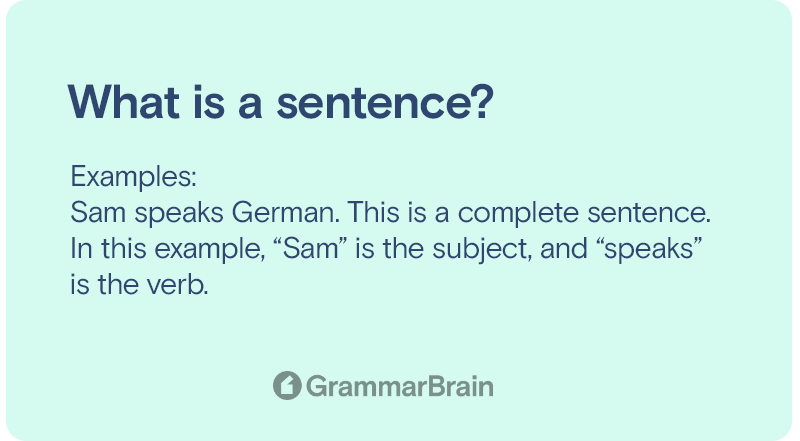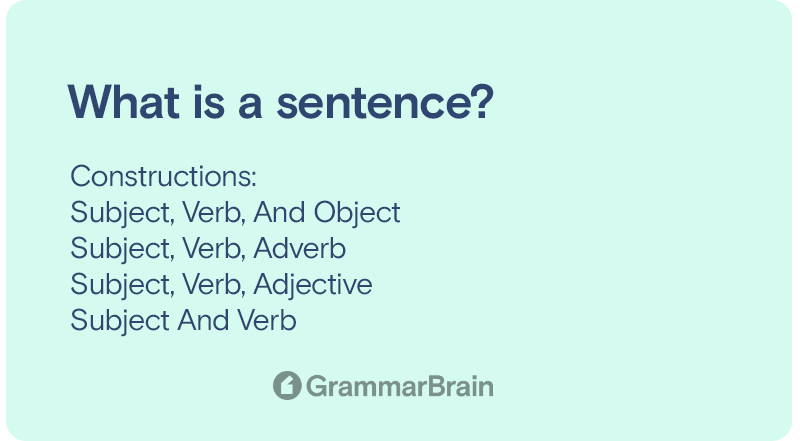What is a sentence? A sentence is a group of words that conveys an idea. Every word in a sentence starts with a capital letter and ends with either a period, question mark, or exclamation mark. The basic structure of a sentence ideally contains a subject and a verb.

What is a sentence?
Simply put, a sentence is a group of words that express a thought, idea, or concept. A complete sentence is one that uses a subject and combinations of verbs + prepositions + pronouns to create communication and dialogue.

What are examples of a sentence?
After the brief explanation of what is a sentence, here are a few examples of how sentences are constructed.
Examples:
- Sam speaks German. This is a complete sentence. In this example, “Sam” is the subject, and “speaks” is the verb.
- Who Is John sitting with? This is an interrogative sentence. Here, “John” is the subject, and “sitting” is the verb.
- Sam and John are eating lunch at the moment. In this example, the sentence has two subjects which are “Sam” and “John” and the verb is “eating”.
Sometimes sentences have the subject hidden. For example, “Wash the clothes”. In this sentence, the hidden subject is “you” and the verb is “wash”.

Different ways of constructing a sentence
Following are the different ways of constructing a sentence.
Subject, Verb, and Object
An example of this type of sentence is “Shawn eats a banana”. Here, “Shawn” is the subject, “eats” is the verb, and “banana” is the object.
Subject and Verb
An example of this type of sentence is “John swims”. Here, “John” is the subject, and “swims” is the verb.
Subject, Verb, and Adverb
“He walked quickly” is an example of a “subject-verb-adverb” sentence. In this example, “he” is the subject, “walked” is the verb, and “quickly” is the adverb.
Subject, Verb, and Adjective
“She looks beautiful” is an example of a “subject-verb-adjective” sentence. Here, “she” is the subject, “looks” is the verb, and “beautiful” is the adjective.
What are the different purposes of a sentence?
A sentence can issue a command, ask a question, or convey a fact or information. Here is a list of the different purposes of a sentence in detail.
Declarative sentence
This type of sentence conveys an opinion, or feeling, or makes a statement. Declarative sentences end with a period.
Examples:
- John is feeling jubilant after winning the match. This is a declarative statement that expresses a feeling.
- Sam plays excellent football. This example conveys an opinion.
- She wants to be an excellent basketball coach. This example makes a statement.
Interrogative sentence
Interrogative sentences are those sentences that ask questions. These sentences end with a question mark.
Examples:
- Where is he going? This is an interrogative sentence.
- Did he join the basketball team?
- Who is Sam talking to?
Imperative sentence
This type of sentence is used to issue a command or make a request for something. It usually ends with a period but sometimes it also ends with an exclamation mark.
Examples:
- Please wash the utensils. In this example, the subject is requesting to perform an action. Here, the subject is “you” which is hidden.
- I want you to go to the grocery store. Here, the subject is commanded to perform an action. The subject is “you” and the verb is “go”.
Exclamatory sentence
Exclamatory sentences convey emotions in general. These could be expressing sorrow, happiness, or angry feelings. Such sentences end with an exclamation mark.
Examples:
- Wow, I am feeling ecstatic today! This sentence expresses happiness.
- Gosh, I feel pathetic! This sentence expresses anger or frustration.
Sentences are structured in different ways. Here are the four ways to structure them.
The four sentence structures
- The Simple Sentence
- The Compound Sentence
- The Complex Sentence
- The Compound-Complex Sentence
The simple sentence
A simple sentence structure is made up of a single clause and has no dependent clauses.
Examples:
- She eats sandwiches for lunch every day.
- Tom likes to sleep in the afternoon.
The compound sentence
A compound sentence structure contains two independent clauses or more. These independent clauses are joined with a coordinating conjunction like “and”, “or”, etc.
Examples:
- Tom plays guitar and his sister plays the violin.
- Shawn eats cereal for breakfast and his father has toast for breakfast.
The complex sentence
The complex sentence contains two clauses. One is an independent clause and the other one is a dependent clause. These clauses are connected with the help of a subordinating conjunction.
Examples:
- I eat biscuits when I am hungry. In this sentence, “I eat biscuits” is the independent clause which is followed by a subordinating conjunction “when” and then comes the dependent clause.
- I love fruits because they are healthy. Here, “I love fruits” is the independent clause followed by subordinating conjunction “because” and then comes the dependent clause.
The compound-complex sentence
A compound-complex sentence is constructed with at least two independent and one dependent clause.
Examples:
- Amelie starts to prepare the meal and her daughter sets the table when Amelie’s husband comes home after work.
- John wears a raincoat and Sam takes an umbrella when it rains.
FAQs
1. Can a sentence be a two-word?
Yes, a sentence can be a two-word. For example, “Lions roar”. This is a two-word sentence and is a complete sentence.
2. What is an active voice sentence?
In an active voice sentence, the subject executes the action. For example, “John is eating grapes”. Here, John (subject) is performing the action of eating.
3. What is a passive voice sentence?
In a passive voice sentence, the subject receives the action. For example, “The girl was hit by the ball”.
Sources
- What Is A Sentence? | Grammar | EnglishClub
- Sentence: Definition and Examples
- Sentence – Simple English Wikipedia, the free encyclopedia
- Basic English sentence structure | Wordy
Inside this article
Fact checked:
Content is rigorously reviewed by a team of qualified and experienced fact checkers. Fact checkers review articles for factual accuracy, relevance, and timeliness. Learn more.
Core lessons
Glossary
- Abstract Noun
- Accusative Case
- Anecdote
- Antonym
- Active Sentence
- Adverb
- Adjective
- Allegory
- Alliteration
- Adjective Clause
- Adjective Phrase
- Ampersand
- Anastrophe
- Adverbial Clause
- Appositive Phrase
- Clause
- Compound Adjective
- Complex Sentence
- Compound Words
- Compound Predicate
- Common Noun
- Comparative Adjective
- Comparative and Superlative
- Compound Noun
- Compound Subject
- Compound Sentence
- Copular Verb
- Collective Noun
- Colloquialism
- Conciseness
- Consonance
- Conditional
- Concrete Noun
- Conjunction
- Conjugation
- Conditional Sentence
- Comma Splice
- Correlative Conjunction
- Coordinating Conjunction
- Coordinate Adjective
- Cumulative Adjective
- Dative Case
- Determiner
- Declarative Sentence
- Declarative Statement
- Direct Object Pronoun
- Direct Object
- Diction
- Diphthong
- Dangling Modifier
- Demonstrative Pronoun
- Demonstrative Adjective
- Direct Characterization
- Definite Article
- Doublespeak
- False Dilemma Fallacy
- Future Perfect Progressive
- Future Simple
- Future Perfect Continuous
- Future Perfect
- First Conditional
- Irregular Adjective
- Irregular Verb
- Imperative Sentence
- Indefinite Article
- Intransitive Verb
- Introductory Phrase
- Indefinite Pronoun
- Indirect Characterization
- Interrogative Sentence
- Intensive Pronoun
- Inanimate Object
- Indefinite Tense
- Infinitive Phrase
- Interjection
- Intensifier
- Infinitive
- Indicative Mood
- Participle
- Parallelism
- Prepositional Phrase
- Past Simple Tense
- Past Continuous Tense
- Past Perfect Tense
- Past Progressive Tense
- Present Simple Tense
- Present Perfect Tense
- Personal Pronoun
- Personification
- Persuasive Writing
- Parallel Structure
- Phrasal Verb
- Predicate Adjective
- Predicate Nominative
- Phonetic Language
- Plural Noun
- Punctuation
- Punctuation Marks
- Preposition
- Preposition of Place
- Parts of Speech
- Possessive Adjective
- Possessive Determiner
- Possessive Case
- Possessive Noun
- Proper Adjective
- Proper Noun
- Present Participle
- Prefix
- Predicate



